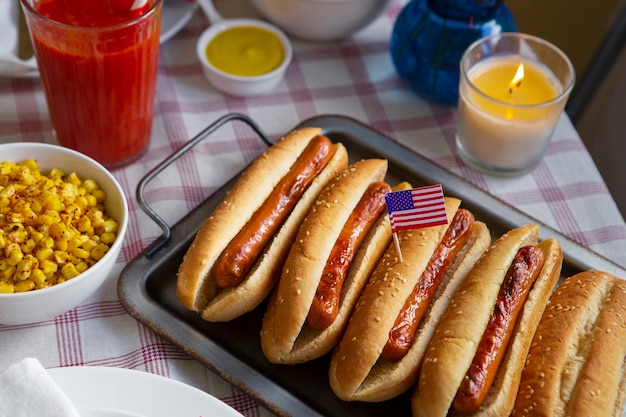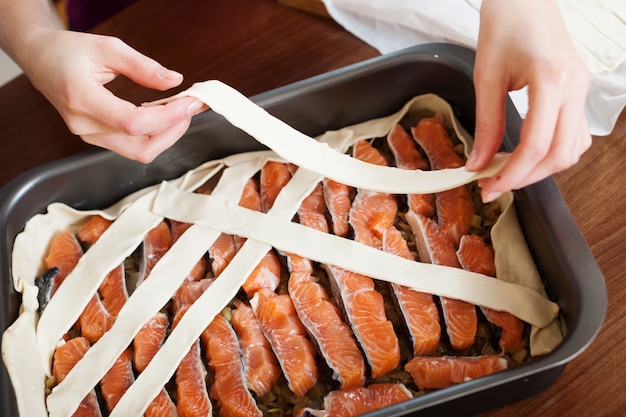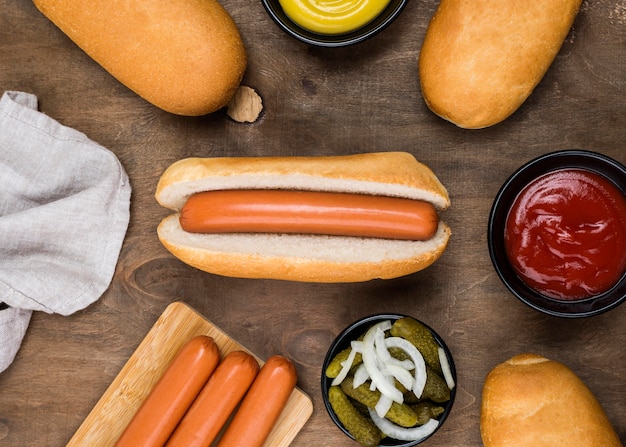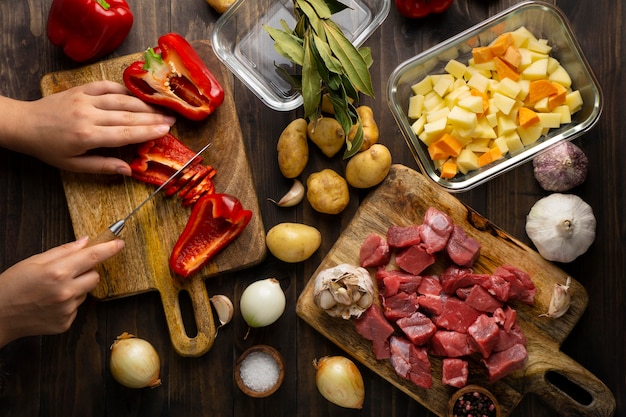(Part 1) Choosing Your Weapons

First things first, we need to gather our ingredients. And when it comes to hot dogs, the choices can be overwhelming, even for a seasoned sausage aficionado like myself.
The Sausage
Now, I'm not going to bore you with fancy, gourmet sausages. We're sticking to the classics here, the everyday heroes: your trusty supermarket hot dogs – beef, pork, or a blend. For me, it's a classic beef hot dog, nothing too fancy, just a good, honest flavour.
But remember, even with classic hot dogs, quality matters. Look for a brand that isn't overly greasy, with a good snap when you bite into it. You'll notice the difference in texture and flavour compared to those mushy, processed sausages – a total hot dog faux pas!
The Pan
Next up, the pan. You don't need anything fancy. A good old-fashioned non-stick pan will do wonders. While cast iron can add a nice char, I find it's a bit too intense for a simple hot dog.
The size of the pan depends on how many hot dogs you're cooking. I usually make 2-3 at a time, so a medium-sized pan is ideal.
The Extras
Now, let's talk about those game-changing extras, the toppings that elevate your humble hot dog to new heights.
- Mustard: The eternal debate: yellow, brown, Dijon – it's all a matter of personal preference. I'm a yellow mustard kind of guy, but feel free to experiment and find your favourite.
- Relish: This adds a sweet and tangy flavour to your hot dog. I'm a big fan of sweet relish, but dill relish and spicy relish are great alternatives.
- Onions: Thinly sliced red onions offer a lovely crunch and flavour. White onions, even caramelized onions, can also be a fantastic addition.
- Pickles: Pickles are a must for any true hot dog enthusiast. They add a tangy flavour and a bit of a crunchy texture.
- Sauerkraut: For a more traditional, German-style hot dog, sauerkraut is a must. It adds a tangy flavour and a delightful texture.
- Chili: If you're feeling adventurous, add a dollop of chili for a hearty and flavorful hot dog. Homemade chili is fantastic, but canned chili is a quick and easy option.
Remember, the possibilities are endless when it comes to hot dog toppings. Don't be afraid to experiment and find your perfect combination!
(Part 2) The Art of the Cook

Now that you've gathered your ingredients, it's time to get cooking.
The Basics
The key to a perfect hot dog is gentle cooking over medium heat. This ensures that the hot dog cooks evenly without drying out. It's also crucial to keep a close eye on the hot dogs, flipping them occasionally to guarantee even cooking on all sides.
The Different Methods
There are a few tried-and-true methods for cooking hot dogs on the stovetop. I'll share my favourite, and then we'll explore some other options.
Method 1: The Classic Pan-Fried
- Heat Your Pan: Start by heating your pan over medium heat. You want it hot enough for the hot dogs to sizzle when you add them, but not so hot that they burn.
- Add Your Hot Dogs: Carefully add the hot dogs to the pan and cook for about 5-7 minutes, turning them occasionally. You're aiming for a hot dog that's cooked through and slightly browned on all sides.
- Rest Before Serving: When the hot dogs are cooked, remove them from the pan and let them rest for a minute or two before serving. This allows the juices to redistribute, resulting in a more succulent hot dog.
Method 2: The Steam-Fry
Here's another classic method that delivers a slightly more tender hot dog:
- Add Water: Add about 1/4 cup of water to your pan and bring it to a simmer.
- Place Your Hot Dogs: Carefully place the hot dogs in the simmering water, submerging them about halfway.
- Steam and Fry: Allow the hot dogs to steam for about 5 minutes. Then, reduce the heat to medium and let them fry in the remaining water for another 5 minutes, turning them occasionally.
The steam helps to cook the hot dogs gently, while the frying gives them a nice crispy crust.
The Temperature Check
If you're unsure about doneness, you can use a meat thermometer. The internal temperature should reach 160 degrees Fahrenheit (71 degrees Celsius) for safe consumption.
(Part 3) Top It Off

Now, for the fun part – transforming these humble hot dogs into culinary masterpieces.
The key to a great hot dog is to keep things simple and let the flavours of the toppings shine through.
The Classics
You can't go wrong with the classics:
- Mustard: A dollop of yellow mustard is a classic for a reason. It adds a tangy kick to your hot dog.
- Relish: A spoonful of sweet relish adds a sweet and tangy flavour that complements the hot dog perfectly.
- Onions: Thinly sliced red onions or white onions provide a nice crunch and a fresh flavour.
Getting Creative
For something a little different, try these combinations:
- The Chicago Dog: This iconic hot dog is a true taste explosion, topped with yellow mustard, chopped white onions, sweet green relish, dill pickle spears, a sport pepper, tomato wedges, and a sprinkle of celery salt.
- The New York Dog: This classic hot dog is topped with mustard and sauerkraut for a simple yet delicious combination.
- The Bacon Dog: Wrap your hot dog in bacon before cooking for a smoky, salty flavour. A decadent treat for those who love a bit of indulgence!
- The Chili Cheese Dog: Top your hot dog with a dollop of chili and a sprinkle of shredded cheese for a hearty and satisfying meal.
- The BBQ Dog: For a smoky and sweet flavour, top your hot dog with a dollop of your favourite bbq sauce. Add some crispy onions for a bit of crunch.
(Part 4) Sides and Drinks
No hot dog feast is complete without the right sides and drinks.
Sides
When it comes to sides, I like to keep things simple. A classic coleslaw or potato salad is always a winner. For something a little more creative, try a corn salad or a fruit salad.
Drinks
For drinks, I always go for something refreshing. A cold beer or a glass of lemonade is perfect on a hot day. You can also serve iced tea or fruit punch.
(Part 5) The Ultimate Hot Dog Experience
Now that you've mastered the basics of hot dog cooking, let's elevate your hot dog game.
The Backyard BBQ
There's nothing quite like a good old-fashioned backyard BBQ for enjoying hot dogs. Set up a grill, invite your friends and family, and enjoy a casual and fun gathering.
The best part about a backyard BBQ is the focus on spending time with loved ones and enjoying good food. Relax, have fun, and soak up the simple pleasures of life.
The Picnic
Another great way to enjoy hot dogs is on a picnic. Pack your hot dogs, your favourite toppings, and a blanket and head to the park, the beach, or any other scenic spot.
A picnic is a perfect way to enjoy the outdoors and savor the simple pleasures of life. Pack your basket, find a nice spot, and enjoy a relaxing picnic with your loved ones.
(Part 6) Storage and Leftovers
You've cooked up a storm, but you've got leftover hot dogs. No worries, there's a way to make them last!
Storing Cooked Hot Dogs
If you have leftover cooked hot dogs, store them in an airtight container in the refrigerator for up to 3-4 days.
Reheating Leftovers
When you're ready to enjoy those leftover hot dogs, here are a few reheating methods:
- Microwave: Place the hot dogs on a microwave-safe plate and heat them for 30-60 seconds, or until heated through.
- Oven: Preheat your oven to 350 degrees fahrenheit (175 degrees Celsius). Place the hot dogs on a baking sheet and bake for 10-15 minutes, or until heated through.
- Stovetop: Place the hot dogs in a skillet and heat them over medium heat for 5-7 minutes, turning them occasionally.
(Part 7) hot dog history
Ever wondered where the hot dog came from? Let's take a trip down memory lane.
The history of the hot dog is fascinating, filled with interesting twists and turns. It's believed that the hot dog originated in Germany, where sausage makers were renowned for their Frankfurter sausages.
In the late 1800s, German immigrants brought their sausage-making skills to the United States. Frankfurter sausages quickly gained popularity, and street vendors started selling them in buns to make them easier to eat.
The term "hot dog" is thought to have originated in the early 1900s. A cartoonist named T.A. Dorgan, known for his satirical illustrations, used the term to describe the hot sausages being sold by street vendors.
Over the years, the hot dog has become a staple of American cuisine. It's a classic comfort food enjoyed by people of all ages.
(Part 8) hot dog etiquette
Now, I'm not going to get all stuffy on you, but there are a few basic rules to follow when it comes to hot dog etiquette.
Respect the Bun
First and foremost, treat the bun with respect. Don't go stuffing it full of so many toppings that it falls apart. You want a bun that can hold its own and stand up to all the deliciousness inside.
The Toppings
Be mindful of the toppings you choose. If you're eating a hot dog at a hot dog stand or a restaurant, be sure to follow their guidelines. And if you're making your own hot dog at home, remember that less is more. You don't want to overwhelm the flavour of the hot dog with too many toppings.
The Eating
Finally, when it comes to eating the hot dog, use your hands. No one wants to see you struggling with a fork and knife. And be sure to take small bites, savouring every mouthful.
(Part 9) Hot Dog Trivia
Now, to test your hot dog knowledge, here's some fun trivia:
- Did you know that the world's largest hot dog was 1,853 feet long? It was made in Wisconsin in 2007.
- The National Hot Dog and Sausage Council reports that Americans eat an average of 70 hot dogs per person each year!
- In the United States, the Fourth of July is known as National Hot Dog Day.
FAQs
Now, let's address some common questions people have about cooking hot dogs.
1. Can I cook hot dogs in the microwave?
Yes, you can cook hot dogs in the microwave, but it's not my preferred method. microwave cooking can sometimes lead to a rubbery texture.
If you must cook hot dogs in the microwave, pierce the skin of the hot dog with a fork to prevent them from bursting. Heat them for 30-60 seconds, or until heated through.
2. How long should I cook hot dogs on the stovetop?
The cooking time will vary depending on the size and type of hot dog and the heat of your stove. However, as a general rule of thumb, cook hot dogs over medium heat for 5-7 minutes, turning them occasionally.
3. What's the best way to keep hot dogs warm?
Once the hot dogs are cooked, you can keep them warm in a slow cooker or in a preheated oven set to 200 degrees Fahrenheit (93 degrees Celsius). If you're serving hot dogs at a buffet, you can also place them in a chafing dish.
4. Can I cook hot dogs on the grill?
Absolutely! Grilling hot dogs is a great way to add a smoky flavour. Just be sure to preheat the grill and cook the hot dogs over medium heat for 5-7 minutes, turning them occasionally.
5. What are the best toppings for hot dogs?
There's no one right answer to this question, as it's all a matter of personal preference. But some classic toppings include yellow mustard, relish, onions, pickles, sauerkraut, and chili. Feel free to experiment and find your perfect combination!
Everyone is watching

Perfect Rice Every Time: The Ultimate Guide to Cooking Rice
Cooking TipsAs a self-proclaimed foodie, I've always been a bit obsessed with rice. It's the foundation of countless cuisi...

Ultimate Guide to Cooking the Perfect Thanksgiving Turkey
Cooking TipsThanksgiving. Just the word conjures up images of overflowing tables laden with delicious food, the scent of r...

The Ultimate Guide to Cooking Asparagus: Tips, Techniques, and Recipes
Cooking TipsAsparagus. The mere mention of this spring delicacy conjures up images of vibrant green spears, crisp and burs...

Can You Cook Spaghetti with Gasoline? (The Shocking Truth)
Cooking TipsWe've all seen those crazy internet trends. You know, the ones that make you wonder, "Did someone actually try...

Chorizo and Eggs Recipe: The Ultimate Guide
Cooking TipsRight, let’s talk about chorizo and eggs. You know, that classic Spanish dish that's always a winner. It's th...
